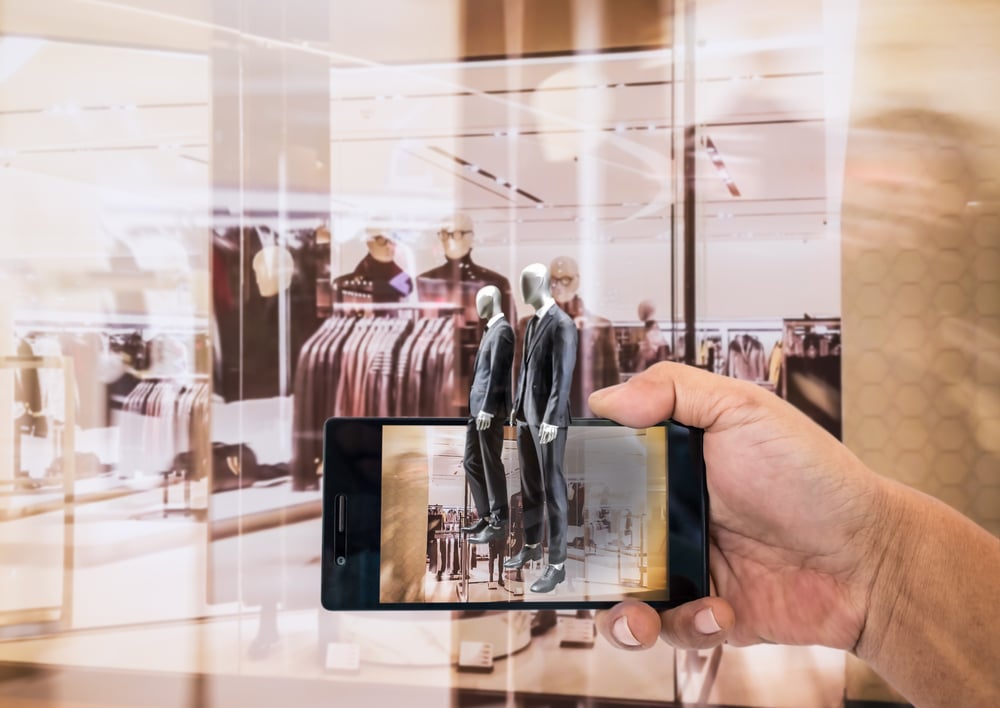Location-based augmented reality is the next iteration of AR in marketing. Early adopters of this technology used strategic partnerships or in-house apps to offer consumers better online shopping experiences. However, as location-based technology improves, these AR experiences can also delight consumers in the store and encourage them to interact with products on the shelves.
AR is more popular than virtual reality, its predecessor, as it’s more accessible. When using virtual reality, consumers must use often expensive equipment that cuts them off from the physical world. For obvious reasons, this creates limitations in marketing. Augmented reality is much more flexible, as it’s accessible without expensive hardware. It also allows the consumer to enhance their experience in the shopping aisle by adding useful digital components.
Early Uses of Augmented Reality in Retail
Ikea was one of the earliest retailers to leverage augmented reality in retail to improve the consumer shopping experience. The company rolled out an app in 2016 called Ikea Place. With it, consumers are able to scan their living spaces with their phone’s camera and virtually drag and drop in Ikea furniture to determine if it’s a good fit. The company reportedly generated $35.7 billion in revenue in the year of the app’s release, and many attributed the increased sales to the new technology. There are several reasons why this app was such a sales driver for Ikea, though, the three most prevalent are:
- It was unique: AR was still in its earliest stages in 2016 and wasn’t yet in mainstream use. By getting in early, Ikea took advantage of industry-changing technology which drove consumer interest.
- It solved a problem: Ikea didn’t create an AR app just to have one. They built it to fill a common need from consumers who were online furniture shopping. As furniture is expensive and difficult to return, consumers are hesitant to purchase without knowing how it will look in their space.
- It offers social integration: Users of Ikea Place can share their finished room designs on Instagram and WhatsApp, which provides additional marketing for the retailer. Consumers may see the items on someone else’s feed and purchase them for their own homes, or try out the app for themselves. Either path increases brand affinity.
Ikea provided an excellent example of the early use of augmented reality and how it impacted online marketing. Many brands are following suit and releasing their own apps to capitalize on this. The most innovative brands are looking at how AR can work not just online, but in the shopping aisle.
The most innovative brands are looking at how AR can work not just online, but in the shopping aisle.
How Location-Based Augmented Reality Improves In-Store Shopping
 Levi’s gained attention when the brand held an in-store augmented reality event with the help of Snapchat. The brand created a limited-edition Mickey Mouse hat which was only obtainable by visiting an Orlando location. When they visited the store, shoppers were invited to scan a Snapcode which unlocked the AR feature. Once enabled, consumers could view how they’d look in the hat via their phone’s camera, and then order it online. The event was successful for many reasons, but mainly because it leveraged three critical components of location-based augmented reality campaigns.
Levi’s gained attention when the brand held an in-store augmented reality event with the help of Snapchat. The brand created a limited-edition Mickey Mouse hat which was only obtainable by visiting an Orlando location. When they visited the store, shoppers were invited to scan a Snapcode which unlocked the AR feature. Once enabled, consumers could view how they’d look in the hat via their phone’s camera, and then order it online. The event was successful for many reasons, but mainly because it leveraged three critical components of location-based augmented reality campaigns.
- Gamification: Gamification encourages app retention by turning everyday processes into fun experiences that reward consumers. Shopkick uses this strategy in its app. Consumers use the app to discover products in the store, scan UPCs, and gain kicks (aka rewards points) for the brief interaction. Levi’s leveraged gamification by tying it to a specific location and rewarding consumers for visiting.
- Scarcity: Consumers could only access the code and the option to buy the hat while at the Orlando location. As they had a limited window to purchase, this heightened their desire to do so.
- Exclusivity: The exclusivity of this campaign mainly targeted Disney fans and tourists, who’d likely want a collectible piece of merchandise to memorialize their visit. As the hat was harder to obtain, consumers likely gave it a higher implied value.
As with most AR strategies, a partnership drove this marketing campaign. Most brands who choose AR select this route as partnering with a third-party who has already developed the technology is more cost-effective. Augmented reality apps can be challenging to create and implement, and retailers may have no way of knowing if the ROI is worth it until after the campaign. Partnerships can give them an earlier view of how much their customers like this technology, so they can determine if it’s worth creating a branded app.
Location-based augmented reality is still in its infancy, but it’s a promising area for marketers. This technology encourages product interaction and customer engagement when used in the store. It can be leveraged in the creation of one-off events to announce a special product, or it can work to solve everyday consumer issues. In either case, strategic third-party partnerships offset the cost of location-based AR marketing campaigns.
Shopkick helps our partners offer location-based experiences to consumers that drive them to interact with products. To leverage our app and connect with our active user base, contact us.
Image courtesy of Montri Nipitvittaya


